In July of this year, Facebook CEO Zuckerberg and the company team came to the desert of Arizona, watching the Aquila drone rise from the military runway (near the California border), which is the first Facebook unmanned solar aircraft. Fly to the sky.
Aquila's wingspan is similar to that of the Boeing 737. The drone flew for 96 minutes at low altitude, more than three times longer than the original time. Facebook hopes that the carbon fiber drone will fly 90 days in the sky, with a height of about 60,000 to 90,000 feet (about 18,288-27,432 meters), and the test aircraft can only fly 2,150 feet (about 655 meters).
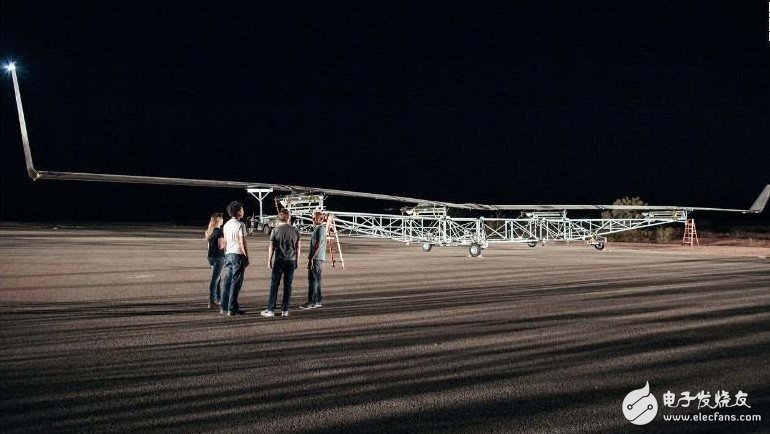
Facebook's vision is this: drones hover in a certain area, using the latest laser technology to cover Internet services to a radius of 30 miles. The antenna and receiver on the ground tower can receive signals transmitted by the drone, and the antenna converts the signal into a Wi-Fi or 4G network. The network speed is very fast and can reach 1Gbps.
Throughout the process, Facebook needs to solve a series of problems: the aircraft collects enough energy during the day to fly, allowing the drone to fly 24 hours; design high-energy, high-density batteries, can effectively store enough energy. Only by solving these problems can Aquila achieve its goal: fly to a height of a few miles from the ground (about 60,000 feet) and fly for more than three months at a time. The current solar drone has a maximum record of only 2 weeks.
Facebook engineering vice president Jay Parikh said: "We still have a lot of work to do."
Two years ago, Facebook acquired the British company Ascenta, which focused on the development of solar drones. Andy Cox is the original owner of Ascenta, who is now the head of the Project Aquila project. At the end of June, the first Aquila drone was built in a warehouse in the Bridgwater Industrial Zone in the United Kingdom. The aircraft was dismantled and transported to Arizona for assembly.

After the test flight, the Aquila drone landed on a stone field because the fuselage was relatively fragile and was injured when landing.
After participating in the test flight, Andy Cox returned to Bridgwater. On the way back to the UK, he told the BBC reporter: "Ultimately we have to fly the aircraft to an altitude of 60,000-90,000 feet, which is higher than the traditional aircraft. It is very cold, and the drone has to stay in the air for more than 3 months. At a given waypoint, the drone can freely circulate and provide Internet service without being affected by other aircraft."
To achieve the goal, all the upper surfaces of the aircraft should be equipped with solar cells, and the shape of the aircraft should be aerodynamic and as light as possible. Cox said that the aircraft must be light, with a little more weight and a little more power.
Aquila drone technology detailed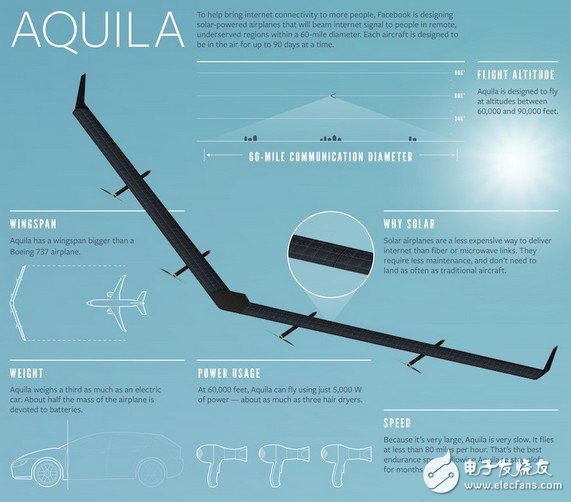
Zuckerberg said that the original plan was to let Aquila fly for 30 minutes, because things went very smoothly, and finally decided to let the plane fly for 96 minutes, collecting a lot of data, data related to the mode, aircraft structure!
Regarding Aquila's technology, Zuckerberg made the following statement.
Weight: Aquila's wingspan is wider than Boeing 737. To make the airplane stay at high altitude for a longer period of time, the weight is of course as light as possible. For this reason, the body of the Aquila drone is made of carbon fiber composite material and weighs less than 1,000 pounds, which is equivalent to the weight of a grand piano.
Energy: During the day, Aquila draws energy from the sun. Only by collecting enough energy can the aircraft advance, communicate with the ground, and operate the avionics. At night, the heating and lighting systems will function properly. When sailing at cruising altitude, the drone requires approximately 5,000 watts of electricity, equivalent to three blowers.
Control: Aquila is automatic in most of the time. It still needs the support of ground personnel, including dozens of engineers, pilots, technicians who guide, maintain and monitor the operation of the aircraft. Ground personnel control the aircraft through software to determine the direction, altitude and air speed of the aircraft. They can also dispatch Aquila aircraft based on GPS lines. The take-off and landing of the aircraft is automatic. After all, the landing position of the human pilot is not software accurate.
Speed: When watching Aquila flight, one thing might be surprising: it's flying very slowly. This is intentional. In order for the aircraft to fly with as little energy as possible, the speed is naturally as slow as possible. At higher altitudes, the air is thinner, and Aquila will be faster, about 80 miles per hour (about 129 kilometers).
Height: In order to take off, fly, and land, Aquila's wings and propellers must operate at cold altitudes and at low altitudes. The air density at low altitudes is 10 times higher than at high altitudes. We try to figure out how much energy the aircraft needs to fly at various altitudes, and how much it affects solar panel performance, battery size, range of motion, and performance over time.
Load: About half of Aquila's weight comes from high-energy batteries. The battery is heavy and needs to be mounted on a large wing, which is why Facebook uses a computer model to predict the shape of Aquila under load. In the future, Facebook will develop more aircraft to better understand the actual flight conditions of the aircraft.
Communication: Aquila will carry communication tools that can transmit data with lasers 10 times faster than existing systems. During the move, the laser can precisely aim a coin 11 miles away.
Hard-working companies are not just FacebookIn some remote areas, there are countless people who can't use the Internet. Facebook wants to offer cheap Internet services to these people, and other companies have the same idea. Kerri Cahoy, an associate professor of aerospace at MIT (MIT), said that the pace of innovation in technology giants and startups is accelerating, and we have entered a new era of experimentation.
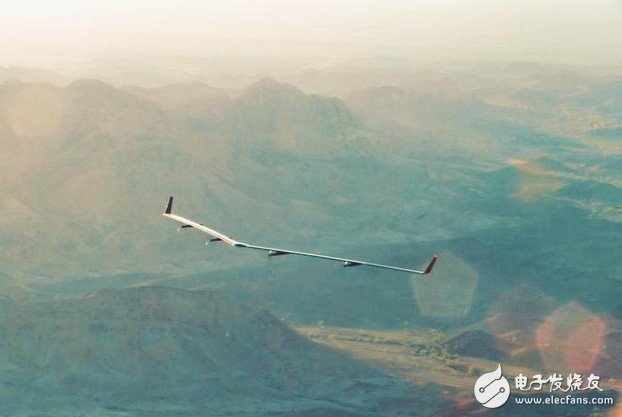
Google's parent company, Alphabet, is implementing the Project Loon project, which uses high-altitude, wind-energy balloons to transmit Internet signals. The balloon hovered at high altitude, about twice as high as a business jet, and it can transmit Internet signals. OneWeb Satellites is a joint venture between startup OneWeb and Airbus Defense and Space. Its goal is to develop a new generation of small advanced satellites to provide Internet services, primarily to developing countries. SpaceX also wants to provide Internet services using satellites.
Kah said: "The situation is exciting. I really hope that these technologies can make breakthroughs, make things possible, or take a big step forward."
Christopher Lum, an assistant professor of aerospace research at the University of Washington, believes that the use of solar-powered aircraft to provide high-speed Internet is not new. Aircraft like Aquila have been studied, such as the solar aircraft Helios developed by the US military and NASA.
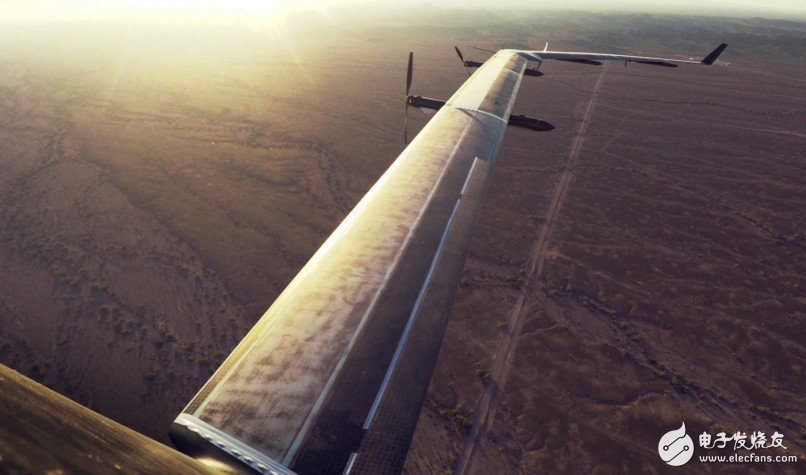
Stanford professor Andrea Goldsmith believes that Facebook and Google face great challenges in building infrastructure in the air. Since the 1980s, Goldsmith has been studying wireless communication technology.
Goldsmith said: "The transmission efficiency of non-terrestrial communication networks is not high. Because of this, all the wireless communication we use is basically through the ground, at least the services that are often used, such as mobile phones and Wi-Fi. Goldsmith also said that Facebook and Google are trying to provide high-performance services at relatively low cost, which looks very attractive.
Duke University professor Mary Cummings believes that Facebook has done things before. Cummings said: "Put the equipment in the air and then provide the service, but also make the cost low enough to achieve it very difficult. Yes, you can send the plane to the sky, it can fly, but it can be commercialized. What?†Cummings was a US Navy fighter pilot. She is now the head of the Human and Autonomous Laboratory at Duke University.
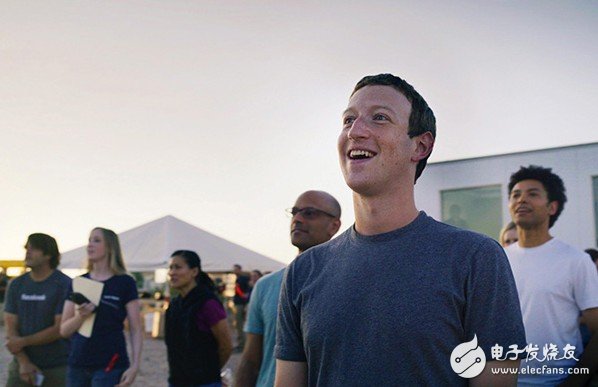
Facebook and Google are more motivated than other companies. why? Because their business depends on the growth of overseas users, they want to provide services to everyone on the planet. Facebook CTO Michael Schroepfer said the company's goal is to drastically reduce Internet access costs. He said: "There is a big challenge, and more than half of the population on the planet cannot access the Internet."
Business may not workThe Facebook drone began its test flight on June 28th, and the successful test flight made the company a big step toward the goal. Facebook has established a dedicated team to explore new technologies, including aircraft, satellite, wireless communication systems, and the team is called "Facebook ConnecTIvity Lab."
Aquila is one of the most ambitious projects on Facebook. The Aquila drone weighs only a third of the car. When the aircraft is raised to cruising altitude, it only needs 5000 watts of power to drive, similar to three hair dryers. During the test flight, Facebook collected design and operational information.
Facebook engineering vice president Jay Parikh said that in the next few years, Aquila will conduct a series of tests, and later Aquila can fly faster, higher, and farther, and the aircraft will continue to evolve. Facebook is preparing to add more aircraft to the test fleet, which vary in size and weight.
When is the technology ready for use? Goldsmith believes that it is still impossible to assert that when it comes to see how technology evolved, some promising concepts have been proposed, but ultimately failed.
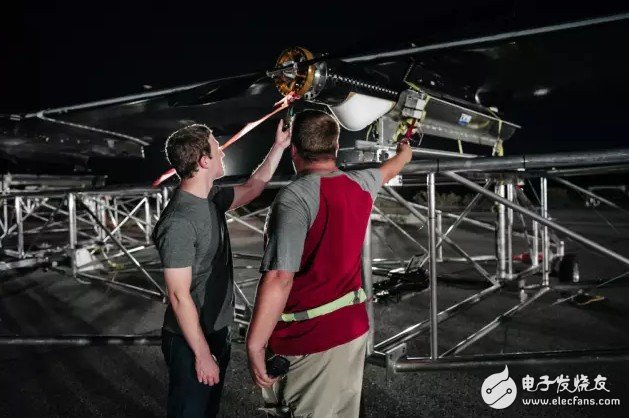
For example, the satellite phone company Iridium, which was founded in 1998, connects satellites to form a network that covers every region of the world. Iridium wants everyone to use satellite phones, which will install cell towers in the air, with cellular Network competition.
"The two major network competitions, which will dominate the commercial wireless communications, was not clear at the time." Goldsmith said, "In the end, compared with terrestrial transmission, the cost of air transmission is too high, and the cellular network is full. Victory."
Although the test is successful, Facebook still has a lot of work to do. The drone is the same width as the Boeing 737, but weighs less than 1,000 pounds, mostly batteries. To fly in the sky for a few months, the team must reduce the weight of the aircraft.
Who is going to operate the drone? Facebook avoids talking. Previously, Facebook engineering global director Jay Parikh said that the company has no intention of becoming an aircraft manufacturer or an Internet service provider, and the actual deployment will be done by local Internet providers and governments.
Printed ESD Shielding Membrane Switch
Printed Esd Shielding Membrane Switch,Electronic Infusion Pump Membrane Switch,Electronic Membrane Switch,Silver Pet Membrane Switch
Dongguan Nanhuang Industry Co., Ltd , https://www.soushine-nanhuang.com